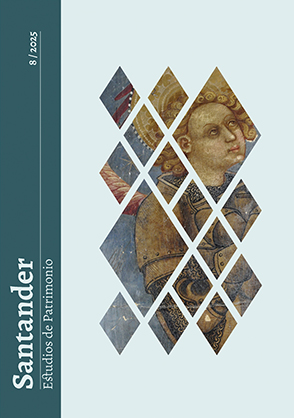The Trust Joyero of Zaragoza, “the house of choice for intelligent and tasteful people”
DOI:
https://doi.org/10.22429/Euc2025.sep.08.11Keywords:
contemporary commercial architecture, culture of consumption, jewelry, silverware, watchmaking stores, El Trust, Modesto Largo Álvarez, Joaquín Figueras Luna, Sixto Genzor Aguirán, ZaragozaAbstract
At the beginning of the contemporary era, Europe witnessed the emergence of new commercial spaces, largely connected to the formation of the nineteenth-century city and to new everyday rituals and ways of consumption. Among those novel establishments were the jewellery, silver and watch shops, which, under the name of El Trust, were characterised by the elegance of their premises. The first ones founded in Spain opened their doors in Madrid in 1906 and, two years later, they settled in Zaragoza. This article aims to outline the history of El Trust in Zaragoza and to emphasise the importance of the establishment as a place for the consumption of sumptuary objects.
Downloads
References
ALONSO, Luis Enrique y CONDE, Fernando, Historia del consumo en España: una aproximación a sus orígenes y primer desarrollo, Madrid, Editorial Debate, S.A., 1994.
BARCIELA, Carlos (ed.), Autarquía y mercado negro. El fracaso económico del primer franquismo, 1939-1959, Barcelona, Crítica, 2003.
DÍEZ CALVO, Patricia, El Bazar X y su historia (1904-1974), historia de un comercio zaragozano, Zaragoza, Institución Fernando el Católico, 2023.
FORCADELL ÁLVAREZ, Carlos y FERNÁNDEZ CLEMENTE, Eloy, “Crecimiento económico, diversificación social y expansión urbana en Zaragoza, 1900-1930”, en GARCÍA DELGADO, José Luis (ed.), Las ciudades en la modernización de España. Los decenios interseculares, Madrid, Siglo XXI de España Editores, S.A., 1992, pp. 435-457.
GARCÍA-HENCHE, Blanca y CUESTA-VALIÑO, Pedro, “Patrimonio comercial de los centros históricos. El caso de los Comercios Centenarios de Madrid, como estrategia para mantener los valores culturales en los barrios históricos”, Journal of Tourism and Heritage Research, 5/1 (2022), pp. 348-369, https://dialnet.unirioja.es/servlet/articulo?codigo=9058147
GERMÁN ZUBERO, Luis, “Aragón 1900-1930. Atraso económico y dualismo interno”, en AA. VV., Historia de Aragón. II. Economía y sociedad, Zaragoza, Institución Fernando el Católico, 1996, pp. 214-221.
GERMÁN ZUBERO, Luis, Historia económica del Aragón contemporáneo, Zaragoza, Prensas de la Universidad de Zaragoza, 2012.
GUIJARRO MORA, Víctor, “Retórica y persuasión en los catálogos comerciales españoles de material científico-educativo (1920-1936)”, Llull, 43, 87 (2020), pp. 177-196, https://dialnet.unirioja.es/servlet/articulo?codigo=7602754
LÓPEZ SOBRADO, Esther, Luis Quintanilla (1893-1978). Estampas y dibujos en el legado de Paul Quintanilla (catálogo de la exposición celebrada en el Paraninfo de la Universidad de Cantabria, 26 de mayo-16 de julio de 2005), Santander, Universidad de Cantabria. Fundación Bruno Alonso. Caja Cantabria, 2005.
LÓPEZ SOBRADO, Esther (comis.), Luis Quintanilla, testigo de guerra (catálogo de la exposición celebrada en el Paraninfo de la Universidad de Cantabria, 20 de noviembre de 2009-9 de enero de 2010), Santander, Universidad de Cantabria. Fundación Bruno Alonso. Consejería de Cultura, Turismo y Deporte del Gobierno de Cantabria, 2009.
MARTÍNEZ HERRANZ, Amparo, Teatro Principal de Zaragoza, 225 años construyendo ciudad, Zaragoza, Ayuntamiento de Zaragoza, 2024.
MARTÍNEZ RUIZ, Julián, “Gaspar Montes Iturrioz”, Boletín de la Real Sociedad Bascongada de los Amigos del País, XLV, 3-4 (1989), pp. 551-588.
MORADIELLOS, Enrique, La España de Franco, 1939-1975. Política y sociedad, Madrid, Síntesis, 2008.
NONELL, Jorge, “Escaparates”, Arte Comercial. Revista Técnica de Publicidad y Organización, 13 (1948), pp. 55-57.
OROPESA MÁRQUEZ, Salvador A., Literatura y comercio en España: las tiendas (1868-1952), Málaga, Universidad de Málaga, 2014.
POBLADOR MUGA, María del Pilar, La arquitectura modernista en Zaragoza: revisión crítica, Zaragoza, Diputación General de Aragón. Departamento de Cultura y Educación, D. L., 1992.
POBLADOR MUGA, María del Pilar, La arquitectura modernista en Zaragoza (tesis doctoral, Universidad de Zaragoza), 1994.
RUIZ MARÍN, Julián, Memoria amante y personal de las calles de Zaragoza, Tomo I, Zaragoza, Artes Gráficas UBAU, 1991.
TORGUET ESCRIBANO, Nardo, La reforma urbana en la Zaragoza de mediados del siglo XIX. Apertura de la calle Alfonso I (1858-1868), Zaragoza, Ayuntamiento de Zaragoza, 1987.
VÁZQUEZ ASTORGA, Mónica, Cafés de Zaragoza. Su biografía, 1797-1939, Zaragoza, Institución Fernando el Católico, 2015, https://ifc.dpz.es/recursos/publicaciones/35/01/_ebook.pdf
VÁZQUEZ ASTORGA, Mónica, “¡París llega a Zaragoza! Los Grandes Almacenes El Águila, templo para el consumo y el ocio”, Archivo Español de Arte, 97, 387 (2024), pp. 1289-1304, https://dialnet.unirioja.es/servlet/articulo?codigo=9824492
VEBLEN, Thorstein, Teoría de la clase ociosa, México, Fondo de Cultura Económica, XXV, 1974.
Published
How to Cite
Issue
Section
License
Copyright (c) 2025 Mónica VÁZQUEZ ASTORGA

This work is licensed under a Creative Commons Attribution-NonCommercial-NoDerivatives 4.0 International License.
- The journal Santander. Estudios de Patrimonio keeps the copyright of the published texts, but it promotes and allows the reutilisation of them under the Creative Commons licence Attribution + Noncommercial + NoDerivatives 4.0, as it is explained in the section Licence and in this link.
- All the texts of this journal are published in the electronic edition of the journal under the indicated licence that allows to copy, use, spread, transmit and expose them publicly, as long as the author, the URL and the journal are mentioned, and the texts are not used for commercial purposes.
- The authors agree with the licence of use of this journal, with the autoarchive conditions and with the open access policy.
- In case of reutilisation of the works published in this journal, the editorial origin has to be mentioned. Thus, the following statement stablished by the editor has tu be included:
- Originally published in Santander. Estudios de Patrimonio in the [number] of the year [year in digit], University of Cantabria (Spain). Furthermore, a link to the version of the editor has to be provided, with this sentence: The original publication is available in Santander. Estudios de Patrimonio (including the link).

















